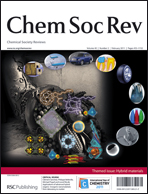Periodic mesoporous organosilicas (PMOs) prepared by surfactant-directed polycondensation of bridged organosilane precursors are promising for a variety of next-generation functional materials, because their large surface areas, well-defined nanoporous structures and the structural diversity of organosilica frameworks are advantageous for functionalization. This critical review highlights the unique structural features of PMOs and their expanding potential applications. Since the early reports of PMOs in 1999, various synthetic approaches, including the selection of hydrolytic reaction conditions, development of new precursor compounds, design of templates and the use of co-condensation or grafting techniques, have enabled the hierarchical structural control of PMOs from molecular- and meso-scale structures to macroscopic morphology. The introduction of functional organic units, such as highly fluorescent π-conjugates and electroactive species, into the PMO framework has opened a new path for the development of fluorescent systems, sensors, charge-transporting materials and solid-state catalysts. Moreover, a combinational materials design approach to the organosilica frameworks, pore wall surfaces and internal parts of mesopores has led to novel luminescent and photocatalytic systems. Their advanced functions have been realized by energy and electron transfer from framework organics to guest molecules or catalytic centers. PMOs, in which the precise design of hierarchical structures and construction of multi-component systems are practicable, have a significant future in a new field of functional materials (93 references).

You have access to this article
 Please wait while we load your content...
Something went wrong. Try again?
Please wait while we load your content...
Something went wrong. Try again?


 Please wait while we load your content...
Please wait while we load your content...